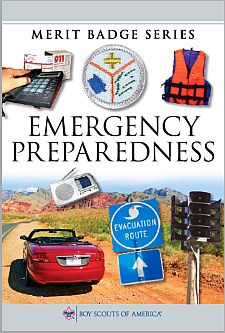Either this Merit Badge or Lifesaving MB
is Required to earn the Eagle Scout Rank
- Earn the First Aid Merit Badge.
- Do the following:
- Discuss with your counselor the aspects of emergency preparedness:
- Prepare for emergency situations
- Respond to emergency situations
- Recover from emergency situations
- Mitigate and prevent emergency situations
- Make a chart that demonstrates your understanding of each of
the aspects of emergency preparedness in requirement 2a (prepare,
respond, recover, mitigate, and prevent)
with regard to 10 of the situations listed below. You must
use situations 1, 2, 3, 4, and 5 below in boldface but
you may choose any other five listed here for a total of 10 situations.
Discuss this chart with your counselor.
- Home kitchen fire
- Home basement/storage room/garage fire
- Explosion in the home
- Automobile accident
- Food-borne disease (food poisoning)
- Fire or explosion in a public place
- Vehicle stalled in the desert
- Vehicle trapped in a blizzard
- Flash flooding in town or in the country
- Mountain/backcountry accident
- Boating accident
- Gas leak in a home or a building
- Tornado or hurricane
- Major flood
- Nuclear power plant emergency
- Avalanche (snowslide or rockslide)
- Violence in a public place
- Meet with and teach your family how to get or build a kit, make a plan, and be informed for the situations on the chart you created for requirement 2b. Complete a family plan. Then meet with your counselor and report on your family meeting, discuss their responses, and share your family plan.
- Discuss with your counselor the aspects of emergency preparedness:
- Show how you could safely save a person from the following:
- Touching a live household electric wire.
- A room filled with carbon monoxide
- Clothes on fire.
- Drowning using nonswimming rescues (including accidents on ice).
- Show three ways of attracting and communicating with rescue planes/aircraft.
- With another person, show a good way to transport an injured person out of a remote and/or rugged area, conserving the energy of rescuers while ensuring the well-being and protection of the injured person.
- Do the following:
- Tell the things a group of Scouts should be prepared to do,
the training they need , and the safety precautions they should
take for the following emergency services:
- Crowd and traffic control
- Messenger service and communication.
- Collection and distribution services.
- Group feeding, shelter, and sanitation.
- Identify the government or community agencies that normally handle and prepare for the emergency services listed under 6a, and explain to your counselor how a group of Scouts could volunteer to help in the event of these types of emergencies.
- Find out who is your community's emergency management director and learn what this person does to prepare, respond to, recover from, and mitigate and prevent emergency situations in your community. Discuss this information with your counselor and apply what you discover to the chart you created for requirement 2b.
- Tell the things a group of Scouts should be prepared to do,
the training they need , and the safety precautions they should
take for the following emergency services:
- Take part in an emergency service project, either a real one or a practice drill, with a Scouting unit or a community agency.
- Do the following:
- Prepare a written plan for mobilizing your troop when needed to do emergency service. If there is already a plan, explain it. Tell your part in making it work.
- Take part in at least one troop mobilization. Before the exercise, describe your part to your counselor. Afterward, conduct an "after-action" lesson, discussing what you learned during the exercise that required changes or adjustments to the plan.
- Prepare a personal emergency service pack for a mobilization call. Prepare a family kit (suitcase or waterproof box) for use by your family in case an emergency evacuation is needed. Explain the needs and uses of the contents.
- Do ONE of the following:
- Using a safety checklist approved by your counselor, inspect your home for potential hazards. Explain the hazards you find and how they can be corrected.
- Review or develop a plan of escape for your family in case of fire in your home.
- Develop an accident prevention program for five family activities outside the home (such as taking a picnic or seeing a movie) that includes an analysis of possible hazards, a proposed plan to correct those hazards, and the reasons for the corrections you propose.
| For Requirement 9a you may wish to use this checklist: (The checklist is already included in the worksheets below.) |
Word Format | PDF Format |
BSA Advancement ID#:
6
Requirements last updated in:
2013
Pamphlet Publication Number:
35888
Pamphlet Stock (SKU) Number:
615832
Pamphlet Revision Date:
2012
| Worksheets for use in working on these requirements: | Format | |
|---|---|---|
| Word Format | PDF Format | |
Page updated on: November 18, 2021









